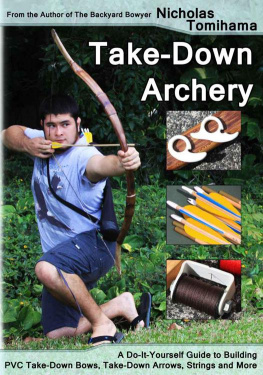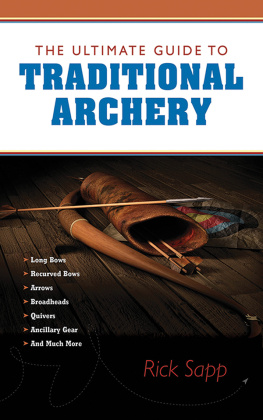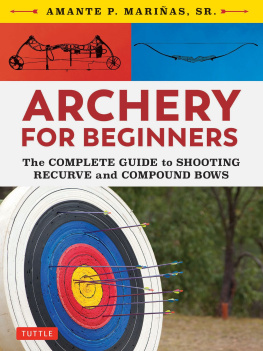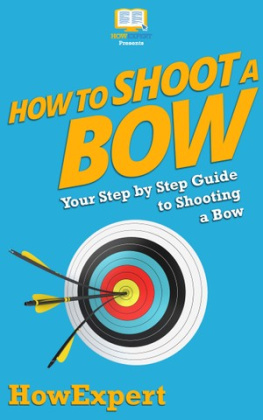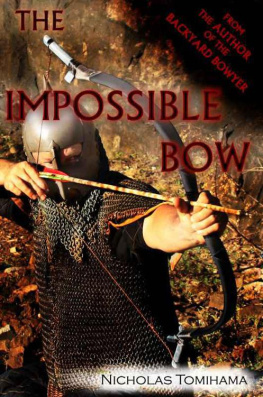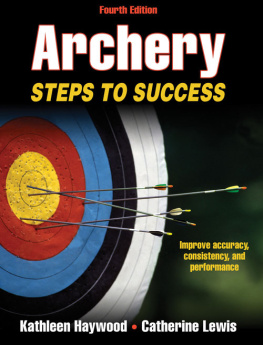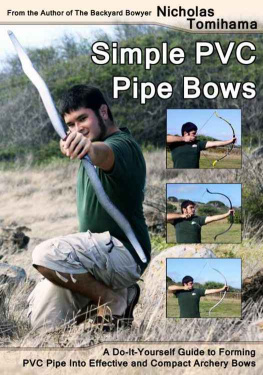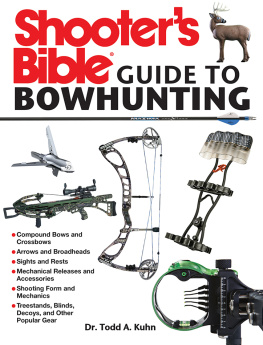
Take Down Archery
A Do-It-Yourself Guide to Building PVC Take-Down Bows, Take-Down Arrows, Strings and More
Nicholas Tomihama
Take-Down Archery
Levi Dream
Copyright 2012 Nicholas Tomihama
www.backyardbowyer.com
Printed in the United States of America
First Printing in 2012
All rights reserved. No part of this book may be reproduced in any form, by any means including but not limited to mechanical, photographic, or electronic process, or in the form of a phonographic recording, nor may it be stored in a retrieval system, transmitted, or otherwise be copied without permission from the publisher in writing.
This book is intended as an informational guide. The views expressed within are solely the opinions of the author, based on personal experience. All instructions within this book must be followed with caution, and the author, publisher, printer and all other parties involved deny any responsibility for injury to both body and property due to the misuse of information contained herein .
This book is a description of the process the author takes to make simple PVC pipe bows. The results portrayed in the book are as done by the author and are not indicative of work done by other individuals. While the information is presented in a clear and concise manner, the author makes no guarantee that following the instruction will yield the same quality work. Nor does the author, publisher, printer and all other parties involved suggest following the instructions within as they carry risk inherent to all forms of archery and the bowyers craft.
Bows are inherently dangerous weapons and care must be taken during the use and manufacture of them. No bow is indestructible and every bow, regardless of strength can hurt, maim or kill. Never point a bow at another person, animal or into a place that may not be clear. Only use safe equipment when practicing archery. All minors must be supervised by a responsible adult.
For Angie, Levi and Noah
He that giveth heed unto the word shall find good;
And whoso trusteth in the Lord,
happy is he.
- Proverbs 16 : 20

Table of Contents
Chapter One Getting Started
Welcome to Take-Down Archery ! Well be going over some of the basic parts of a bow, how PVC take down bows work and some things to think about before building your own equipment. By the end of this book you should be able to put together an archery kit that is effective, safe and can be packed down into a backpack or bag. Well start with some bow anatomy.
PVC Bow Anatomy

The types of bows in this book are simple and while they may each look a little different, they all have the same parts. The main body of the bow is broken up into three main parts. They are the riser, limbs and ends of the bow.
The riser is located in the center of the bow and consists of the handle and fades. The handle is the are where the hand grips the bow and the fades are the transition or fade from limb to handle. An arrow rest, which is where an arrow sits when the bow is in use, is located on the handle.
The limbs are the part of the bow that do the most work and take up the most space. There are two separate limbs, one upper and one lower. Each limb has a back, which faces away from the archer when the bow is held and a belly, which faces the archer when the bow is held. Well go over the importance of the back and belly in the next section.
At the end of each limb are the bows nocks and the limb tips. The limb tips may be recurved, which means the string curls over the limb when the bow is strung. If the string touches or rests only on the string nocks, the bow is not considered a recurve. The nocks are where the bow string sits, effectively connecting the ends of a bow.
Bows can come in many shapes and most can be described in a few simple terms. A reflex is any curve in a bow that curves away from the archer, while a deflex curves toward the archer. A recurve is essentially a hard reflex at the tip of a bow. Reflex and deflex can happen in different places in the same bow. Next well go over how these things plus some other aspects can make a bow that performs well.

Some different bow shapes. The bows in this book use combinations of reflex, recurves and deflex in order to bring out the most in each.
How a PVC Bow Works
When it comes to a simple bow, efficiency is all about energy storage and transfer. An efficient bow is able to put the most energy into an arrow with minimal input. While the idea of PVC bows usually evokes images of pipes with strings on them, a bow made in this way will not be very efficient.
A bow is essentially a spring. When the bow is drawn back, energy is stored. When the string is released, energy is released. In order to work well, a bow must be able to store a large amount of energy and then release most of it into the arrow.

The top bow flexes mainly in the middle because it is essentially a straight stick of equal strength along its length and is not very efficient. The bottom bow gradually reduces in strength from handle to tip and is very efficient.
A bow that is equally strong along its entire length, much like a straight stick or a PVC pipe, will flex the most in the middle when strung. This happens because the act of stringing a bow pulls the limbs backward and inward. If the whole bow is equally strong, something has to give and the middle is put under the most strain. Because PVC pipe is so flexible, it can work this way. Most other materials would break under such strain.
A bow that flexes only in one spot, while it can store a great deal of energy, cannot release that stored energy easily. Most of it feeds back into the bow. So while a bow like this can store energy, its inability to use it effectively lowers the amount of energy it can make use of. If the bow is able to flex in more than one place, it is able to release that stored energy better.
A simple way to understand this is to imagine if you were holding two 10 foot long poles. Trying to swing those forward, like they were bow limbs, would be very difficult to do. In the end, you would expend a lot of energy and the poles would move very slowly. Now if you cut each pole into ten pieces and had nine other people with you, each person could swing their arms very quickly. Put together, the same distance would be traveled with less strain on the individual and with more speed.
Most traditional bows work in this way. By spreading out the strain, these bows are able to store and release energy efficiently. Traditional bows achieve this by reducing the amount of material as you move from handle to tip. This can be done by removing more material from the tip than the center or adding more material near the center of the bow.
With a PVC pipe bow, which is essentially a hollow pipe, these things cannot be easily done. Instead, there is a little trick that can mimic the effect of less material by progressively weakening the pipe.
A cylinder gains strength from its circular cross section. This cross section makes it stable in all directions equally. Yet if the shape is compromised and the cylinder flattens to an oval cross section, it will be stronger in one direction than the other. By manipulating this, a bow can be made from PVC pipe that is stiff in the handle with limbs that flex evenly.
Next page
